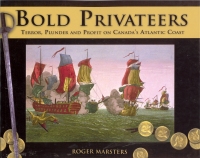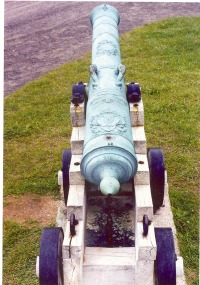| ________________
CM . . .
. Volume XI Number 15 . . . .April 1, 2005
excerpt:
Bold Privateers is an historical account of the men and the ships that plundered and pillaged Atlantic Canada and the New England coast from the late 17th century to the end of the War of 1812-1814. This was done with the tacit approval of the French and British, and later, the American governments. The men were rogues, little different from the pirates who terrorized the Caribbean and their bold deeds similar to what are today considered acts of terrorism. Certainly it took courage to attack unarmed settlements on the Newfoundland coast, but so too do the suicide bomb attacks in Palestine. Their actions were exciting, much like those of the legendary outlaws Bonnie and Clyde or Billy the Kid. The years covered in Bold Privateers were often treacherous ones for people living in the eastern part of North America. Until France's defeat by General James Wolfe in 1759, both the French and the English would do anything to harm their enemy. At stake was the control of North America and the settlements both countries had established since the start of the 17th century. This led to acts of daring and bravado and the elevation of the perpetrators to something akin to cult status. Similar acts were repeated during the American Revolution and the War of 1812 with American colonists replacing the French as Britain's adversaries. The role of the men in Bold Privateers has often been ignored in the retelling of these struggles. This book helps to redress the balance. There are eleven chapters in Bold Privateers. The first seven deal with individuals, most of whom will be unknown to readers. The most famous is Pierre Le Moyne D'Iberville who raided English settlements and fur trading posts at the end of the 17th century. The others, equally courageous, are Pierre Maisonnat, Pierre Morpain, Jean-Vincent d'Abaddie and his son, Bernard Anselme d'Abaddie, the third and fourth Barons of Saint-Castin, Joannis-Galand d'Olabaratz, John Rous and Sylvanus Cobb. Chapter eight deals with New Englanders who pillaged the Nova Scotia coastline prior to the American Revolution. Nova Scotia privateers who harassed French and Spanish ships at the time of the French Revolution are the subjects of Chapter 9. Chapters 10 and 11 are about two ships, Liverpool Packet and Sir John Sherbrooke, that terrorized New England shipping during the War of 1812-14.
Illustrations are an important part of Bold Privateers. They are spread throughout the book and make the stories come alive. Marsters has included pictures of the privateers and their ships, most in colour. There are numerous paintings of maritime scenes, a number a full page in size. They are very attractive, the kind associated with coffee table books. There are also pictures of pistols, cannons, swords, maps and many of the communities mentioned in the book. With a little imagination, readers can quite easily picture the events that transpired so long ago. Bold Privateers has an index and bibliography. It is a scholarly book, well written, historically accurate and will be enjoyed both by teenagers and their parents. It is meant for recreational reading. Highly Recommended. Thomas F. Chambers is a retired college teacher living in North Bay, ON.
To comment
on this title or this review, send mail to cm@umanitoba.ca.
Copyright © the Manitoba Library Association. Reproduction for personal
use is permitted only if this copyright notice is maintained. Any
other reproduction is prohibited without permission.
NEXT REVIEW |
TABLE OF CONTENTS FOR THIS ISSUE
- April 1, 2005.
AUTHORS |
TITLES |
MEDIA REVIEWS |
PROFILES |
BACK ISSUES |
SEARCH |
CMARCHIVE |
HOME |

 Roger Marsters is a specialist in old books and documents for a Halifax book dealer. He has also acted as an interpreter at the Maritime Museum of the Atlantic in Halifax and previously wrote Shipwreck Treasures.
Roger Marsters is a specialist in old books and documents for a Halifax book dealer. He has also acted as an interpreter at the Maritime Museum of the Atlantic in Halifax and previously wrote Shipwreck Treasures.